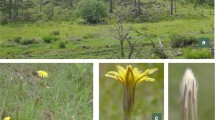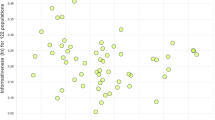Abstract
We studied isozyme variation at 21 loci in 66 populations from three subspecies of Pinus contorta Dougl.; 35 in spp. latifolia, 20 in spp contorta and 11 in spp. murrayana. The objectives were to assess gametic disequilibria and multilocus structure. There was considerable differentiation of allele frequencies at 19 polymorphic loci across the 66 populations and within the subspecies. Allele frequencies at many loci correlated with geographic variables. Genetic variability varied considerably among populations within subspecies but the subspecies means were similar. The mean number of polymorphic loci and the mean heterozygosity over 19 polymorphic loci were, respectively, 13 and 0.194 in latifolia, 12 and 0.196 in murrayana, and 12 and 0.180 in contorta. The mean heterozygosity correlated with longitude and altitude across the 66 populations and with latitude in latifolia. Gametic disequilibria were evident in 40 populations; 29 in latifolia, eight in murrayana and three in contorta. Gametic disequilibria correlated with latitude across the 66 populations and with longitude in latifolia. The single-locus F ST averaged 0.0339 in latifolia, 0.0567 in murrayana, and 0.0764 in contorta. The multilocus F STM was 0.1227 in latifolia, 0.2926 in murrayana, and 0.3328 in contorta. Multilocus Wahlund and founder effects, migration patterns, and natural selection, probably played significant roles in generating and maintaining the multilocus genetic structure in P. contorta in general and the subspecies latifolia in particular.
Similar content being viewed by others
References
Avery PJ, Hill WG (1979) Distribution of linkage disequilibrium with selection and finite population size. Genet Res 33:29–48
Baker RJ (1986) Selection indices in plant breeding. CRC Press, Boca Raton, Florida, USA
Barton N, Clark A (1990) Population structure and processes in evolution. In: Wöhrmann K, Jain SK (eds) Population biology. Springer-Verlag, Berlin, pp 115–173
Boyle TJB (1985) The mating system and population structure of black spruce in central New Brunswick and its influence on tree improvement strategy. PhD dissertation, University of New Burnswick, Canada
Brown AHD, Moran GF (1981) Isozymes and the genetic resources of forest trees. In: Conkle MT (ed) Proc Symp on Isozymes of North American Forest Trees and Insects. US For Serv Tech Rep PSW-48, pp 1–10
Brown AHD, Nevo E, Zohary D (1977) Association of alleles at esterase loci in wild barley Hordeum spontaneum. Nature 268:430–431
Clegg MT, Allard RW, Kahler AL (1972) Is the gene the unit of selection? Evidence from two experimental populations. Proc Natl Acad Sci USA 69:2474–2478
Cockerham CC (1969) Variance of gene frequencies. Evolution 23:72–84
Critchfield WB (1980) Genetics of lodgepole pine. USDA For Serv Res Pap WO-37
Dancik BP, Yeh FC (1983) Alllozyme variability and evolution of lodgepole pine (Pinus contorta var latifolia) and jack pine (P. banksiana) in Alberta. Can J Genet Cytol 25:57–64
Epperson BK, Allard RW (1987) Linkage disequilibrium between allozymes in natural populations of lodgepole pine. Genetics 115:341–352
Epperson BK, Allard RW (1989) Spatial autocorrelation analysis of the distribution of genotypes within populations of lodgepole pine. Genetics 121:369–377
Feldman MW, Christiansen FB (1975) The effect of population subdivision on two loci without selection. Genet Res 24:151–162
Hedrick P, Jain S, Holden L (1978) Multilocus systems in evolution. Evol Biol 11:101–184
Karlin S (1978) Mathematical population genetics. Academic Press, New York
Kendall MG, Stuart A (1966) The advanced theory of statistics, vol 3. Design and analysis, and time series. Charles Griffin, London
Laurie-Ahlberg CC, Weir BS (1979) Allozymic variation and linkage disequilibrium in some laboratory populations of Drosophila melanogaster. Genetics 92:1295–1314
Long JC (1986) The allelic correlation structure of Gainj- and Kalam-speaking people. 1. The simulation and interpretation of Wright's F statistics. Genetics 112:629–647
Loveless MD, Hamrick JL (1984) Ecological determinants of genetic structure in plant populations. Annu Rev Ecol Syst 15:65–95
Mardia KV, Kent JT, Bibby JM (1979) Multivariate analysis. Academic Press, London
Muona O (1982) Potential causes for multilocus structure in predominantly outcrossing populations. Silva Fenn 16: 107–114
Muona O, Szmidt AE (1985) A multilocus study of natural populations of Pinus sylvestris. In: Gregorius HR (ed) Population genetics in forestry. Springer-Verlag, Berlin, pp 241–252
Nei M (1973) Analysis of gene diversity in subdivided populations. Proc Natl Acad Sci USA 70:3321–3323
Nei M, Li WH (1973) Linkage disequilibrium in subdivided populations. Genetics 75:213–219
Perry DJ, Dancik BP (1986) Mating system dynamics of lodgepole pine in Alberta, Canada, Silvae Genet 35:190–195
Rao CR (1965) Linear statistical inference and its applications. John Wiley and Sons, New York
Roberds JH, Brotschol JV (1985) Linkage disequilibrium among allozyme loci in natural populations of Liriodendron tulipifera L. Silvae Genet 34:137–141
Sinnock P (1975) The Wahlund effect for the two locus model. Am Nat 109:565–570
Smouse PE, Neel JV (1977) Multivariate analysis of gametic disequilibrium in the Yanomama. Genetics 85:733–752
Stern K, Roche L (1974) Genetics of forest ecosystems. Springer-Verlag, New York
Waller DM, Knight SE (1989) Genetic consequences of outcrossing in the Cleistogamous annual, lmpatiens capensis. III. Interlocus associations. Heredity 63:1–9
Weir BS (1990) Genetic data analysis. Sinauer Associates, Sunderland, Massachusetts, USA
Weir BS, Cockerham CC (1984) Estimating F-statistics for the analysis of population structure. Evolution 38:1358–1370
Wheeler NC, Guries RP (1982) Population structure, gene diversity, and morphologivcal variation in Pinus contorta Dougl. Can J For Res 12:595–606
Wright S (1951) The genetical structure of populations. Ann Eugen 15:323–354
Yeh FC (1989) Isozyme analysis for revealing population structure for use in breeding strategies. In: Gibson GL, Griffin AR, Matheson AC (eds) Breeding topical trees: population structure and genetic improvement strategies in clonal and seedling forestry. Oxford Forestry Institute, Oxford, UK, and Winrock international Arlington Virginia, USA, pp 119–131
Yeh FC, El-Kassaby YA (1980) Enzyme variation in natural populations of Sitka spruce (Picea sitchensis). I. Genetic variation patterns among trees from 10 IUFRO provenances. Can J For Res 10:415–422
Yeh FC, Layton C (1979) The organization of genetic variability in central and marginal populations of lodgepole pine Pinus contorta spp. latifolia. Can J Genet Cytol 21:487–503
Yeh FC, O'Malley D (1980) Enzyme variation in natural populations of Douglas-fir, Pseudotsuga menziesii (Mirb.) Franco, from British Columbia. I. Genetic variation patterns in coastal populations. Silvae Genet 29:83–92
Yeh FC, Morgan K (1987) Mating system and multilocus associations in a natural population of Pseudotsuga menziesii (Mirb.) Franco. Theor Appl Genet 73:799–808
Yeh FC, Chiliak WM, Dancik BP, Illingworth K, Trust DC, Pryhitka BA (1985) Population differentiation in lodgepole pine, Pinus contorta spp. Latifolia: a discriminant analysis of allozyme variation. Can J Genet Cytol 27:210–218
Author information
Authors and Affiliations
Additional information
Communicated by P. M. A. Tigerstedt
Rights and permissions
About this article
Cite this article
Yang, RC., Yeh, F.C. Multilocus structure in Pinus contorta Dougl.. Theoret. Appl. Genetics 87, 568–576 (1993). https://doi.org/10.1007/BF00221880
Received:
Accepted:
Issue Date:
DOI: https://doi.org/10.1007/BF00221880




